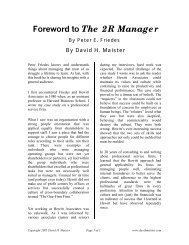pdf version - David Maister
pdf version - David Maister
pdf version - David Maister
Create successful ePaper yourself
Turn your PDF publications into a flip-book with our unique Google optimized e-Paper software.
The Anatomy of a Consulting Firm<br />
up. A less leveraged firm at the same<br />
rate of growth will need to bring along a<br />
higher percentage of its juniors, thus<br />
providing a greater promotion incentive.<br />
Leverage and Profitability<br />
A consulting firm’s leverage is also<br />
central to its economics. The rewards of<br />
partnership or ownership (the high levels<br />
of compensation attained by vice<br />
presidents or senior partners) come only<br />
in part from the high hourly (or daily)<br />
rates that the top professionals can<br />
charge for their own time. A significant<br />
portion of profits derives from the<br />
surplus generated from hiring staff at a<br />
given salary and billing them out at<br />
multiples of that salary. By leveraging<br />
its high-cost seniors with low-cost<br />
juniors, the professional firm can lower<br />
its effective hourly rate and thus reduce<br />
its cost to clients while simultaneously<br />
generating additional profit for the<br />
partners.<br />
The market for the firm’s services will<br />
determine the fees it can command for a<br />
given project; its costs will be<br />
determined by the firm’s ability to<br />
deliver the service with a cost-effective<br />
mix of junior, manager and senior time.<br />
If the firm can find a way to deliver its<br />
services at the same quality with a<br />
higher proportion of juniors to seniors, it<br />
will be able to achieve lower servicedelivery<br />
costs. (Note that this is true<br />
whether the firm bills by the hour or on a<br />
fixed-fee basis.) The project team<br />
structure of the firm is therefore an<br />
important component of firm<br />
profitability.<br />
The Client Marketplace<br />
Degrees of client contact and<br />
customization vary from to firm, or even<br />
practice area to practice area. Some<br />
differences between types of practice are<br />
shown in Figure 1. This defines four<br />
kinds of professional practice, which for<br />
the purposes of example we’ll call<br />
Pharmacist, Nurse, Brain Surgeon and<br />
Psychotherapist.<br />
The Pharmacist<br />
A Pharmacy practice is one where the<br />
client is trying to buy a relatively<br />
familiar service and does not require<br />
very much counseling, consultation or<br />
contact. The client wants the service<br />
performed to strict technical standards at<br />
a minimal cost. Notice that this type of<br />
practice is defined as a standardized<br />
process conducted with little, if any,<br />
client contact. This does not mean that<br />
the result cannot be highly customized,<br />
merely that the process to be followed in<br />
producing the result is well specified.<br />
While this type of work is common in<br />
systems installation and other IT firms, it<br />
can also be found in high-end strategy<br />
firms, where component analyses of cost<br />
structures, market shares, competitive<br />
positioning and many other studies, as<br />
valuable as they can be, have been<br />
highly proceduralized and can be<br />
conducted with thoroughness and<br />
accuracy by junior staff. The method of<br />
conducting these analyses does not vary<br />
from job to job.<br />
Quality standards, in the sense of<br />
“conformance to specifications,” must<br />
be high for this work, since the client<br />
will be “swallowing the pills.” However,<br />
the client does not require that the pill be<br />
specifically designed for him or her. The<br />
client wants to buy well-established<br />
methodologies and procedures, not<br />
innovation and creativity.<br />
The client is in effect saying, “I have a<br />
headache, and I know that you, along<br />
with many others, are licensed to<br />
dispense aspirin. Don’t waste your time<br />
and mine trying to convince me that it’s<br />
Copyright 2005 <strong>David</strong> H. <strong>Maister</strong> Page 3 of 3 www.davidmaister.com











